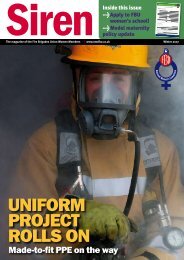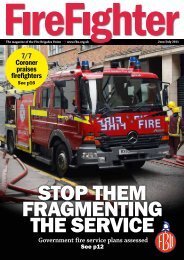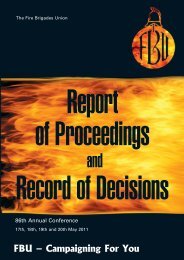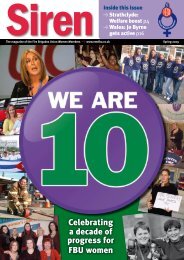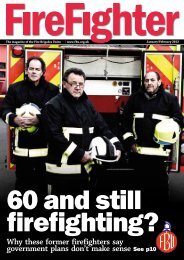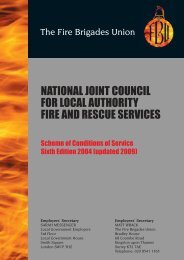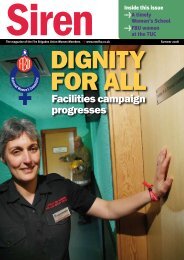FBU Bethnal Green - Fire Brigades Union
FBU Bethnal Green - Fire Brigades Union
FBU Bethnal Green - Fire Brigades Union
- No tags were found...
You also want an ePaper? Increase the reach of your titles
YUMPU automatically turns print PDFs into web optimized ePapers that Google loves.
Findings of the<strong>FBU</strong> Health and Safety Investigationinto the fatal firewhich occurred at<strong>Bethnal</strong> <strong>Green</strong> Roadon 20 July 2004
SECTION HEADINGCONTENTSPAGE1 INTRODUCTION 32 COMMENTS ON THE TIMELINE/OUTLINE OF EVENTS43 OUTLINE OF EVENTS 4-84 FINDINGS AND POINTS OF CONCERN 85 PROFILES OF CREW MEMBERS 96 RECOMMENDATIONS 10-196.1 COMMAND AND CONTROL6.2 FOCUS ON BA INCLUDINGBA TRAINING6.3 REAL FIRE TRAINING6.4 THE TRAINING REGIME IN LONDONFIRE BRIGADE6.5 PERSONNEL RESOURCES6.6 OTHER PERSONNEL ISSUES6.7 COMMUNICATION6.8 PROCEDURES6.9 LONDON SAFETY PLAN6.10 IRMP, RISK ASSESSMENT, RISK PLANNING6.11 ACCIDENT INVESTIGATION ANDOUTCOMES10-1111-1313-1414-151515-16161617-1919192
SECTION 1: INTRODUCTIONThe <strong>FBU</strong> safety representatives who have been conducting the <strong>Union</strong>’s safetyinvestigation into the deaths of Adam Meere and Billy Faust have found their tasksomewhat impeded by the decision of the Coroner, for understandable reasons, to restrictthe access of <strong>FBU</strong> officials to witnesses and others who the safety representatives wishedto interview in order to ensure that a comprehensive report could be compiled.This instruction by the Coroner was relayed to the <strong>FBU</strong> via the Brigade some time after theinvestigation had started, which has allowed us to make a basic timeline and draw therelevant conclusions. However, it has inevitably made the work slower and has contributedto the delay in producing this report. The report which has been produced is therefore notas comprehensive in detail as we would have liked, and as was first planned. However weare confident of the accuracy of the findings and conclusions within the Report.It was recognised early on that our findings and our conclusions may not be popular withsome, and to a few may cause embarrassment. This is not our intention. However, anyaccident report has to be frank and honest. It probably goes without saying that a reportsuch as this has been difficult to write given that it addresses causes that led to the loss oftwo <strong>FBU</strong> members’ lives.The <strong>FBU</strong> Health and Safety Team comprised of:Andy DarkIan LeahairMick ShawMatt WrackJoe MacveighKarl HaiderChris McMahonPaul EmberyShaun PennellTim DavisAndy WatsonGordon FieldenSteve StanleyLead Accident InvestigatorLead Scene Investigator and Investigation Team memberLead Official - Investigation ReviewInvestigation ReviewInvestigation Team memberInvestigation Team memberInvestigation Team memberInvestigation Team memberInvestigation Team memberInvestigation Team memberInvestigation Team memberInvestigation Team memberInvestigation Team memberI would like to thank the entire Investigation Team for their hard work, and patience duringthis very difficult and demanding investigation. The Team would like to thank the officers ofthe London <strong>Fire</strong> Brigade for the assistance they gave.Most importantly of all, the Team would like to thank the officers and firefighters whoattended the scene for assisting us with the investigation.We would like to echo the sentiments contained in the contemporary notes of an OPTIofficer who was at the incident who identified that the hard work of those present “shouldnot go unrecognised within the general malaise of the incident”Andy DarkFor and on behalf of the <strong>FBU</strong> Accident Investigation Team3
SECTION 2: COMMENTS ON THE TIMELINE/OUTLINE OF EVENTSIn the immediate aftermath of the incident, every firefighter found themselves seekinganswers to the same questions as those who were investigating the incident - who haddone what, who had stood where, and who had heard or noticed this that or the other.The answers to these questions are fundamental to establishing the sequence of events,actions and decisions surrounding the deaths of Bros. Meere and Faust. They are of greatimportance in answering the questions of their families, close friends and colleagues.This report does not address these issues in close detail. This is for two reasons. Firstly,the restrictions placed upon the <strong>FBU</strong> safety representatives have created a position wherewe are unable to ascertain precise facts and to test the sources and reliability of theinformation provided by witnesses and other evidence. Secondly, the safetyrepresentatives had been able to collect sufficient information that could provide us with abroad outline of the events and actions which took place both before and after theestimated time of death.What quickly became clear was that there were readily identifiable failures which could besaid to have contributed to, and certainly did not prevent, the deaths of Adam and Billy.Though some may feel partial responsibility for what happened, there should be anunderstanding that the underlying responsibility for the causes for these failings area afailure of management in providing safe systems of work and the resources and training toensure their implementation.The outline of events has been determined by analysis of photographic evidence andwitness recollections (prior to the decision of the Coroner).SECTION 3: OUTLINE OF EVENTSOn 20 th July 2004 at 04:38 hours four appliances from <strong>Bethnal</strong> <strong>Green</strong>, Whitechapel andOld Kent Road (F261, F262, F332 and E353) were ordered to attend a fire at 419 <strong>Bethnal</strong><strong>Green</strong> Road. On arrival there was light wispy smoke emerging at roof level from a threestorey shop and dwellings. Immediate measures were put into effect to rescue twopersons from the roof of the building via 135 ladder. First aid was given by both Brigadeand ambulance personnel to the occupants whilst still on the roof.The shop had a metal security shutter and access to the building was difficult. A BAECOwas appointed who was also the pump operator. A two person BA crew with hosereel andcommunications was committed through a first floor window to carry out an upper levelsearch.Entry was eventually made through a side door located down a covered alley on theground floor. There was a large amount of billowing smoke released by the opening of thedoor. A further, second crew with hosereel and communications was committed throughthis door. This was at 05:05.4
The second crew fought their way through the extremely thick smoke and the narrowpassageway made by stored goods to the head of a flight of stairs that led to thebasement. As they went down the stairs the temperature increased and they saw flamesfrom what they felt was the middle of the basement area. They began fighting the fire untilrelieved by a further crew with communications who had entered by the shuttered frontdoor which by now had been forced open.This relief crew was the third BA team to enter the building. They fought the fire until theywere near exhaustion and then handed over to a “fourth” crew (who were in fact the samemembers of the first crew who had been re-committed. This was around 05:24). This“fourth” crew fought the intense fire by attempting to bounce water off the ceiling using ahosereel.By now, the following significant messages had been sent by the Incident Commander:05:12 “Shop and dwellings of 3 floors, 5 metres by 7 metres alight. 2 residents onroof, both suffering from smoke inhalation, being attended by ambulancecrew.”05:12 “Make Pumps four.”This was 34 minutes after the first appliances were ordered.The “Make Pumps Four” led to the ordering to attend being sent to: a PL fromWhitechapel, an ADO, a Command Unit and <strong>Fire</strong> Investigation Unit (F331, F25, O20E,OK15)At around 05:27, the occupants were being removed from the roof (following treatment atroof level by ambulance personnel). Within a few minutes of this it was confirmed thatthere was an access opportunity at the back of the building and that there was heavysmoke emerging at the back. A decision was made to explore opportunities to ventilate atthe back of the building. This was around 05:35.Within a couple of minutes a BA Entry Control point was set up at the rear.The Incident Commander contacted the “fourth” BA crew who were fighting the fire in thebasement via radio to inform them that ventilation was about to commence. The BA crewwere near exhaustion and exited the building at 05:42.The fifth crew, <strong>Fire</strong>fighters Faust and Meere (without communications), were briefed bythis crew as to the conditions prevailing in the basement. <strong>Fire</strong>fighters Faust and Meerewere committed at 05:45 at the same time as a sixth crew was committed to ventilate atthe rear of the building.This was 1 hour and 7 minutes after the first appliances were ordered.Two further significant messages were then sent:05:47 “Shop and dwellings of 3 floors and a basement. 5 metres by 7 metres ofbasement area alight. Two residents rescued from roof level brought toground floor by TL”5
05:48 “Make pumps six”This was 1 hour and 10 minutes after the first appliances were ordered.The “make Pumps Six” saw the mobilisation of Pumps from Bow and Shoreditch, twoADOs, and a DO (F272, F242, F38, A43, F103).Ventilation commenced at the rear, though there was no hose or hosereel supply. At 05:49the ADO took charge and sectorised the incident - “A” at the front and “B” at the rear.Throughout all this time the descriptions of all witnesses outside of the building were oflight grey or wispy grey smoke (other than when the side door and rear windows and doorswere initially opened).Around 05:58 the crew at the rear heard a dull distant thud and a number of witnesses atthe rear noticed a change whereby thick black smoke entrained with flame beganpunching out, resulting in a fireball that burst several metres into the air. The thick smokeemerging at the rear was apparent at the front.Hose had been laid out to the BA crew at the rear but was not charged or deployedbecause of the crews working below.At 06:00 a seventh BA crew (of three) was committed from the front, with an emergencycrew readied. This seventh crew was committed at around the same time the ECO hadconcern for the safety of <strong>Fire</strong>fighters Faust and Meere as they were near to their time ofwhistle. Within a minute or two of being committed this crew heard a distant rumble,experienced the onrush of flame and saw a mass of flame at the back of the shop. Theseconditions evidenced themselves at the front of the shop as thick, hard-billowing darksmoke. A radio message was sent by the seventh crew to Sector Commander A (front ofbuilding) that the sixth crew were unreachable. It was only at this time that a 45mm jet wasbrought into use.This was 1 hour and 22 minutes after the first appliances were ordered.At 06:05 the eighth crew (of two) was committed. At 06:18 (two minutes after the time ofwhistle for <strong>Fire</strong>fighters Faust and Meere) a ninth crew (of three) entered the building. Allcrews in the building have stated that the whole of the first floor was a mass of flames. Thepiles of stock both fuelled the fire and restricted movement and passage.The sixth crew (who had entered at the rear) exited the building at approximately 06:09.At approximately 06:19 - 06:20, the seventh crew heard an ADSU. The five BA wearerswho comprised the seventh and eighth crew searched at floor level on their hands andknees, whilst the flames rolled along the ceiling. They soon located a firefighter casualty.In trying to raise the casualty the BA cylinder and backplate were released.At 06:21 a message was sent from the ADO who was now the incident commander:“Make Pumps 8”This was 1 hour and 43 minutes after the first appliances were ordered.6
On receipt of this make up, Control mobilised pump ladders from Kingsland and Bow(F311 and F271).At 06:21- 0622, the seventh crew were exhausted and left the building, briefing the ninthcrew (of three), who made their way to assist the eighth crew who were trying to extinguishthe flames whilst extricating the casualty. All five members of the eighth and ninth crewscarried the casualty out of the building. The casualty was very soon recognised as beingBrother Adam Meere. An ADO and Stn O (FIT) attempted to resuscitate him until relievedby the paramedics.At 06:25 a message was sent:“50% of first floor alight. Basement alight. 2 jets and BA in use, BA Stage 2implemented”At approximately 06:26 BA crews eight and nine re-entered the building in the same areawhere they had found Brother Meere. There appears to have been uncertainty as towhether the second crew member of the missing BA crew was still missing. A roll call wasmentioned by some members present but we have not been able to confirm whether thiswas completed.At approximately 06:28, the eighth and ninth BA crews left the building because ofexhaustion, because a crew members’ ADSU was sounding and they were low on air.At 06:29 a message was sent from the DO who was now in charge of the incident:“2 firefighters reported missing, crews searching basement area. This is now apersons reported fire. Make ambulances two.”At 06:31 a tenth crew (of two) entered the building. At 06:32 an eleventh crew (of two)entered the building (the same crew as comprised the sixth BA crew). Both teams appearto have entered without being ordered to do so. The two crews found the shop was whollyalight around them. The ninth crew fought the fire with the 45mm hose that was already inthe building whilst the tenth crew took a new 45mm length into the shop.The tenth crew heard an ADSU sounding in the basement and had to try several times toaccess the basement from the stairs. The basement was hotter than the shop. Theycouldn’t take the 45mm jet into the basement as there was insufficient slack. They foundthe second casualty at the bottom of the staircase. They were unable to lift him more thana few steps up the staircase.At 06:42 both the ninth and tenth BA crews had to leave the building through exhaustion.At 06:44 and 06:45 the eleventh and twelfth crews entered the building (the twelfth crewincluded a firefighter from the second BA crew).The twelfth crew fought the fire whilst theeleventh crew made their way to the basement. They found the casualty (Brother BillyFaust) at the dogleg on the basement stairs.At 06:47 a message was sent:7
“1 firefighter removed from the area suffering from severe burns and smokeinhalation. One firefighter still missing. BA crews searching. Roll call carried out.”At 06:49 a thirteenth BA crew (of two) entered the building. The eleventh, twelfth andthirteenth crews fought the fire and retrieved the casualty.By 06:59 the crews had carried Brother Faust to the door to the side alley.At 07:12 a message was sent:“1 further firefighter located and retrieved. All firefighters now accounted for. Allpersons removed.”SECTION 4: FINDINGS AND POINTS OFCONCERNHaving analysed the information gathered during the investigation the <strong>FBU</strong> Health andSafety Accident Investigation Team identified a number of actions, events and decisionswhich give rise to concern. The key issues identified are as follows: Early ventilation at the front by removing the main shutter should have taken placeonce fire and smoke logging was evident. This would have meant that ventilationwould be taking place in the line of sight of the Incident Commander and wouldhave simplified Command and Control and shortened the lines of communication;Crews recommitted into the incident, which should not occur at any incident, least ofall a basement fire; The ECO had many tasks to fulfil instead of dedicating all his time to the duties ofthe ECO;There was no dedicated communications officer at the Entry Control Board;There was very little communication via radio; Radio communications outside the incident were poor which affected Commandand Control; The crews were working to the point of exhaustion when this condition should havebeen realised by themselves and the officers at the scene; There were insufficient crews to provide BA teams, emergency teams or to fulfilfireground tasks; Only three crews were led by an officer. All were Leading <strong>Fire</strong>fighters, one of whomwas temporary;There was little or incomplete organised briefing and debriefing;8
Hose reel jets were being used in this basement fire, with fairly good throw, but littlevolume of water;Ventilation was carried out with no covering jets; Co-ordination of the ventilation process was poor, conditioned mainly by the poorperformance of the radios;Crews were committed into a basement with no communications equipment;BA crews entering the basement included short-service i.e. probationary firefighters;There was no organised clearance of obstruction;There was no organised clearance of flammables from the working area;The fire was not located or fought for a considerable time; Crews being recommitted despite it being essentially one large room and abasement that was alight; Despite suspected flashover/ backdraught the EVAC whistle was not used at anytime;A BA team member’s ADSU was sounding- yet no action was taken;There seemed to be an absence of a plan throughout the incident;There was little or no Command structure;No advice or prompts given re water spray, keep low etc.;There seems to be little or no local knowledge regarding the building itself;Despite crews hearing unexplained dull thuds or bangs within the incident there wasno despatch of an emergency crew with a spare set for crews that may havebecome trapped;Size of and lack of provision of emergency crews.SECTION 5: PROFILES OF CREW MEMBERSOur information regarding the profiles of personnel is limited. However, it is clear thatmany crews contained some inexperienced firefighters. Experience is a valuablecommodity, something that is not always given due recognition by fire servicemanagement. This is something which the <strong>FBU</strong> safety investigators do not agree with. Ithas become Brigade policy to commit inexperienced firefighters into incidents in BA whilstin their probation. There has never been consultation on this matter, nor has it beenpossible to discover when or why the Brigade policy was changed.9
Only three BA teams out of a total of 13 teams committed during the incident were led byan officer. The experience and profile of the officers at the incident also needs to beexamined; for example how many have (i) knowledge-based promotional abilities e.g. <strong>Fire</strong>Service Examinations Board qualification, and (ii) had their competence assessed.SECTION 6: RECOMMENDATIONSThe recommendations submitted here are not fully developed. They are in outline form.They are a reflection of the underlying causes of the problems experienced at <strong>Bethnal</strong><strong>Green</strong> Road. Whilst the implementation of some of these recommendations is relativelystraightforward many require a large amount of preparation and arrangement. The overalltask may seem daunting but the necessary work must be put in hand immediately withsufficient resources for early implementation. It is recognised that many of therecommendations address issues which were not a direct cause of what happened atdawn on 20 th July 2005. However, the purpose of this investigation is not simply toanalyse what happened. Its purpose is to ensure that it does not occur again.Each type of event gives the opportunity to:Check performance;Identify underlying deficiencies in management systems and procedures;Learn from mistakes and add to the corporate memory;Reinforce key health and safety messages;Identify trends and priorities for prevention;Provide valuable information if there is a claim for compensation;Help to meet legal requirements for reporting certain incidents to the authorities.6.1 COMMAND AND CONTROLWe are aware that the Brigade has been making changes to the way it analyses andreviews command at incidents including monitoring. Examples of these are the fairlyrecently promulgated Performance Review of Command, Incident Monitoring and IncidentCommand Operational Notes. It is clear that these are a part of the Brigade’s response tothe fatalities. This is welcome and has been assisted by the <strong>FBU</strong> through the consultationprocess. However, we remain unconvinced that observation and post-event analysis offersmuch other than the opportunity to identify shortcomings.What is required is a commitment to rectify those shortcomings and address thebackground failings. The Brigade has for a long time been very good at providingcommitment on paper. What it fails to produce is commitment in deed. We recommend:1 There needs to be an increase in the number of senior officers available on thefireground. Many officers are now promoted having been successful in using theMinerva simulations i.e. not tested “in the field”;2 It is imperative that skills are practiced and assessed in real time training scenariosand monitoring and assessment is carried out on performance at the fireground;3 This should be carried out by a fully established, expanded “OTPI”;4 Promotion must be on the basis of sound and full evidence of effective decisionmaking on the incident ground.10
The task loading on the Incident Commander was huge. The Brigade has adopted theIncident Command Model which is a suitable model to use. However, the planningprocess relies heavily on information gathering and processing. It is our view thatIncident Commanders require dedicated officers to assist in the information gatheringprocess and thereafter to assist in the implementation and supervision of the plan.Their roles would be cyclical and on-going in the same way as is the IncidentCommand Model. A dedicated Command structure on the Incident ground is availableat more developed incidents with the arrival of a number of senior officers to carry outthese tasks. These senior officers are given specific training in command and controlroles- safety, sector command etc. This resource should be available to the initialIncident Commander.Also we note that whilst the Incident was sectorised, the sector commanders were of arank and role to which specific command role training is not provided. The provision ofan aide-memoire is not a substitute for training and preparation and practice, and canin no way be deemed as being suitable or sufficient.We therefore recommend:5 The Brigade carries out an urgent review of the resources that are available to anIncident Commander to establish a meaningful Command Structure and to assist inmaking the application of the Incident Command Model in the initial stagespracticable.;6 The Brigade carries out an urgent review of the training provided to, and capabilitiesof, Watch Officers in carrying out the functions within a command structure;We also note that OTPI officer felt that there was no command structure in the later stagesi.e. when senior officers had arrived, of the incident and that he felt that he had tointervene to regain command and control.We therefore recommend:7 The Brigade carries out an urgent review of the training provided to, and capabilitiesof, senior officers in carrying out the functions within a command structure;6.2 FOCUS ON BA PROCEDURES INCLUDING BA TRAININGThere were no periodic gauge checks between the crews that did have radios and theBAECO.8 We recommend that guidance on correct procedures needs to be re-issued, reemphasisedby increased levels of BA training and enforced on the incident ground.FRU crews were available yet EDBA crews were not committed.9 We recommend that guidance on correct procedures needs to be re-issued, reemphasisedby increased levels of BA training and enforced on the incident ground.There appears to have been no implementation of correct emergency crew procedure orpreparation for, or awareness of, second set procedure.11
10 We recommend that guidance on correct procedures needs to be re-issued, reemphasisedby increased levels of BA training and enforced on the incident ground.Anecdotally, it would appear that very few firefighters have actually ever trained orpractised with a second set.11 We recommend that a review of the awareness of second set procedure throughoutthe Brigade should be conducted urgently, and if the findings confirm generic nonunderstandingor practising of these procedures, that there should be a review oftraining practice and policy on this procedure.There is an abundance of evidence that crews waited until they were exhausted beforewithdrawing. This is contrary to good fireground practice and Operational Order 91. Alsocrews were entering a severe fire without water a water supply. Some crews relievedothers at the entrance not at the branch. We recommend that:12 Guidance needs to be re-issued, re-emphasised by increased levels of BA trainingand enforced that crews will withdraw / be withdrawn before exhaustion occurs;13 Officers to be trained in the effects of heat stress and how to manage an incidentwhilst avoiding heat stress;14 All personnel to undergo training which involves experiencing heat stress and beingable to observe the effects in others.Location of casualties has proven to have been difficult for crews, even with an ADSUsounding.15 We recommend that the identification or development of locational tracking systemsbe continued and introduced as early as possible.Adherence to BA procedures is risk critical. Since the deaths of firefighters at Villiers Roadand Gillender Street, instead of improved BA training we have watch-based assessments(which can in no way be deemed realistic), where training has to be fitted in and aroundother demands on watches’ time. Increased emphasis on community fire safety measureshas led to a reduction in training.16 We recommend the reintroduction of regular trainer-led BA training courses.The BAECO was task-loaded. This is unacceptable. It was also noted that there wasincorrect storage of the BA sets worn by the two casualties. We are left in no doubt that itwas of little consequence for this particular incident, but at other incidents the need forsafe and proper storage may be vital. We recommend that:17 The procedure in Operational Note 91 regarding BAECOs duties remains extant i.e.that the BAECO must have no other duties or roles other than that of managing theBA Board. Further, that as soon as is practicable, that a junior officer be designatedas the BAECO;18 The procedure in Operational Note 91 regarding tabards remains extant i.e. theneed for a BAECO to don the BAECO tabard is essential;19 That training on correct procedures needs to be re-issued, re-emphasised byincreased levels of BA training and enforced on the incident ground;20 That the BAECO at all times be assisted by a Radio Communications operative;12
21 That the minimum standard of entry control for all incidents be that currently knownas Stage 2;22 A review of Distress to Wearer procedures to ensure that suspect BA sets areimpounded by a designated officer separate from the BAECO and radioCommunications Officer.6.3 REAL FIRE TRAINING AND TRAINING IN FIREBEHAVIOURReal fire training is currently only provided to trainees. The Brigade’s policy is not toprovide carbonaceous real fire training, or to ensure that firefighters undergo this training,nor does it have any policies or plans to introduce planned continuation training in real firetraining for its personnel. Real fire training must include practical demonstration of andguidance on backdraught and flashover. The failure to provide real fire training andpractical and applied training in fire behaviour is as critical as the BA procedures whichunderpin our ability to safely fight fire.The Brigade and Authority have failed to fulfil their policies, obligations, statutoryrequirements and to carry out the advice from ODPM. Section 2(2) of the HASAW makes a general requirement to provide “information,instruction, training and supervision” Regulation 13 of the Management of Health and Safety at Work Regulations 1999makes a general requirement to provide training when there are new or increasedrisks and to new recruits which could be said to apply. GM358 part III Section 7 outlines a recognition of the need to provide realistictraining GM314 part 3 section 10 makes a general provision for attendances on real firetraining courses National Guidance to Principal Officers from ODPM gives clear advice on the needto provide real fire training and comprehensive knowledge of the behaviour of fireand measure the outcomes. The <strong>Fire</strong> Service Guide H&S for managers gives clear advice on the need fortraining to expose firefighters to the hazards in the training environment in order toreduce the risks at the incident ground This same advice is a lift from FSC 5/ 1996 HSE OP8 1996 makes it clear that there is a “legal obligation to train staff to meetthe hazardous situations to which he may encounter (sic)” It was recognised in the Report of the Home Office Review team Blaina 1996 It was also recognised in DCFO letter 11/1999 In the light of the incident at <strong>Bethnal</strong> <strong>Green</strong> following on as it does from the nearfatalityat Telstar House in 2003, it appears unarguable that (HSG 65) HASAWAMHSAW requires the Brigade to meet the requirements to provide practical real firetraining including flashover and backdraught, and training in the other behaviour offire.We therefore recommend:23 An urgent review should be carried out, and action plans to meet the outcomes ofthe review should be devised and implemented quickly. Due regard should be had13
in planning such training to Regulation 13 of the Management of Health and Safetyat work Regulations 1999 which states that “training should be carried out inworking hours.”;24 That the Brigade provides backdraft and flashover training for all personnel whichcannot be provided at the firehouse at Southwark. This should be based uponcarbonaceous fuel, not LPG.6.4 TRAINING REGIME IN LONDON FIRE BRIGADEWe recommend that:25 There must be a review of the quality, effectiveness and completeness of theBrigade’s training and assessment materials and process;26 There are increased resources provided for training provision in the London <strong>Fire</strong>Brigade;27 It cannot be denied that the video and assessment sheet packages may have somevalue. However there has never been an assessment of the effectiveness of thesetools and techniques in embedding knowledge and understanding. This should takeplace as a matter of urgency and the necessary step taken to implement actionbased upon the findings of this assessment. Action plans to meet the outcomes ofthe review should be devised and implemented quickly;28 Basement fires are by their nature one of the most hazardous environments inwhich to fight a fire. There should be a training note or other suitable note outliningstandard operating procedures specifically for approaching and tackling basementfires;29 A practical exercise-based basement fire training programme should be developedand undertaken by personnel with appropriate continuation training;30 The incident at <strong>Bethnal</strong> <strong>Green</strong> Road shows that there is uncertainty and badpractice with regard to basic safe fire-fighting and practical firefighting skills.Opportunities and resources for training and practice must be increased;31 Training has by and large been focussed on assessment. Assessment is importantbut the current methods are bureaucratic, time consuming and have never beenreviewed for their effectiveness. An urgent review should be carried out and actionplans to meet the outcomes of the review should be devised and implementedquickly;32 The curricula for the various statutory exams were a system of knowledge basedlearning which has not been replaced. An urgent review must be carried out forensuring that there is suitable, relevant and extensive knowledge based learning.Action plans to meet the outcomes of the review should be devised andimplemented quickly;33 Training is provided regarding flow rates for extinguishing compartments of differentsize, layout and type;34 Development programmes for Junior Officers are time consuming for watch basedofficers and higher. The time spent on this very bureaucratic assessment regimesdetract from training and practice opportunities. The situation will be worsened withthe advent or introduction of development records for the firefighter role. An urgentreview should be carried out and action plans to meet the outcomes of the reviewshould be devised and implemented quickly;35 There is a suitable and sufficient training and assessment of temporary officers asrecognised following other serious incidents;14
36 Systems are put in place to prevent untrained and unqualified temporary officersfrom being used to cover shortfalls in trained junior officers as recognised followingother serious incidents;37 There needs to be a review of the current methods of training which can meet theshortfalls in performance identified at <strong>Bethnal</strong> <strong>Green</strong> Road e.g. basic firegroundpractice - setting into hydrants early, gauge checks prompted by the ECO, usingjets not hosereels in basements, embedded understanding re volumes of waterdelivered by the various jets;38 There needs to be urgent audit and review of the effectiveness of the move awayfrom trainer-led training to cascade training;39 There must be an audit of training that has been undertaken and a Brigade-widetraining needs analysis. Action plans to meet the outcomes of the review should bedevised and implemented quickly.6.5 PERSONNEL RESOURCESWhilst there were five riders on four of the eight pumping appliances attending theincident, the first three appliances were riding five, four and four. The critical period at anyincident is on, and shortly after arrival, to ensure that sufficient crews are able to (a) carryout an initial search and assessment (b) make the first intervention(s). One rider more orless can make the difference between having an available BA team or not. If all theappliances had been riding five (or indeed six) then there would have been more crewmembers to search, assess, intervene and support. Sufficient officers to lead BA crewsand carry out fireground command and control functions need to be available to theIncident Commander. There also needs to be a review of the minimum number of seniorofficers sent to incidents.We note that at this incident, there was a shortage of crews. This is evidenced by: FIT officer taking a command function; FIT officer involved in firefighting and casualty handling; An ADO who was the safety officer being involved in casualty handling; <strong>Fire</strong>fighters being recommitted for a second wear; Probationary firefighters still being committed even after OTPI had instructed thatcrews should not contain probationers and should be led by junior officers.We therefore recommend:40 Increase minimum size of appliance crew to five including minimum of one WatchCommander and one Crew Commander;41 Minimum attendance to all basement fires to be six pumps;42 Two FRUs to be sent to all basement fires;43 A review of senior officers mobilised to incidents and a review of the number ofsenior officers available to be mobilised by Brigade Control.6.6 OTHER PERSONNEL ISSUESIn Section 4 above we made reference to personnel having relevant training andexperience. Our recommendations are:15
44 The Brigade should re-adopt as policy that probationary firefighters should not becommitted into severe fire incidents or incidents which are not fully under control;45 The Brigade needs to undertake an urgent review of promotion systems and criteriawhich should include a review of the knowledge-based learning and acquisition,length and type of operational service.6.7 COMMUNICATIONThere was very little radio communication between the crew and the BAECO (it issignificant that neither Brother Meere nor Brother Faust had a radio. If they had, it isprobable that the Incident Commander may have withdrawn the crew and/or taken otheractions). We recommend that:46 Guidance on correct procedures needs to be re-issued, re-emphasised andenforced on the incident ground;47 A radio and BA set be identified or developed, so that London firefighters can besupplied with communications integrated into the BA set;48 Until such time that these have been introduced/ developed that BARIE be suppliedfor all BA wearers.As has been previously stated there was little communication between crews and BAECO,not all crews had BARIE equipment, and the radios failed to perform egg between SectorA and Sector B. We therefore recommend that:49 The Brigade pursue the replacement of current radios;50 Replacement radios be tested in an exercise-based training environment andoperationally to ensure that they are fit for the intended use;51 If no suitable radio can be found that an examination be carried out to see whetherthere is available technology which can be carried on/ built into appliances whichwill boost the radio signal and make the radios more effective;52 Each BAECO should be assigned a dedicated Communications Officer.6.8 PROCEDURESThere should be a review of all current operational procedures to ensure that they areappropriate and not in need of updating. Consideration should be given to the introductionof new procedures and concepts including:53 Flooding of basements including the deployment and use of the High VolumePumps;54 Detailed guidance on the use of BA teams and crews to support the lead BA teams(e.g. for hose movement);55 We noted that some crews were entering a severe fire without extinguishing media.Some crews relieved others at the entrance, not at the branch. Brigade wide refamiliarisationon such basics;56 Protected dry hose runs into an incident to prevent/ reduce snagging and“cornering” of hose;57 To ensure effective command and control of BA crews, the advanced elements ofStage 2 should become standard at all incidents.16
6.9 LONDON SAFETY PLANIt is the view of the investigators that it was fortunate, if such word can be used given thecircumstances, that more firefighters were not killed or seriously injured. LFEPA (London<strong>Fire</strong> and Emergency Planning Authority) have introduced a number of policies which havecontributed to the reduction of training opportunities and activity within the Brigade. Theseare contained within London Safety Plan 2003-4 and London Safety Plan 2005-8. TheAuthority has also introduced policies which will undoubtedly worsen the current situation.Moreover its current policies adopted as a result of the IRMP process which gave rise tothe two London Safety Plans have already introduced policies which will impact uponcrews attending such incidents being able to make a safe and effective assessment andoperational intervention. It is our view that the Authority needs to revisit these initiativesand policies. We recommend that:58 The Authority should reverse its decision to expand the roles and trainingrequirements into new fields of activity, particularly where it has no statutoryresponsibilities. A clear example of this is co-responding;59 The Authority has introduced a host of new vehicles to meet the demands of NewDimensions with the resultant demands upon training time and opportunity forpersonnel to undertake training for our more historic roles. The Authority needs toreview whether there is sufficient capacity and numbers of training officers to carryout the training for our historic roles;60 The Authority is heavily committed to Community <strong>Fire</strong> Safety. The Authority mustreview the impact of this workload on training and operations. The computer cultureof watch- based officers being confined to their desks reading and writing emails,having to obey “must-be-done-yesterday” demands for information s via the emailsystem, and completing seemingly endless records –invariably computerised, mustcome to end. Against their wishes and better judgement, watch officers arebecoming office clerks. They have all but lost all the time and opportunity to traintheir personnel at the station and at BA chambers. They are unable to assess theircrews’ ability to implement procedures through practice at joint exercises with othercrews;61 The London Safety Plan 2005-8 states that the Authority is considering taking up to40 appliances on to a mobilising status where they cannot be mobilised to incidentsfor up to one hour due to the dispersal of crews away from the location of theirappliance. This will be known as the “strategic reserve”. This policy will seriouslyhamper the ability of the personnel to train and to respond to incidents. This policyshould be reviewed;62 There should be a Brigade wide audit of work being undertaken by all stations andthe introduction of an action plan to ensure that appropriate measures areintroduced to ensure that training and operational response are given the primaryservice status;63 The Authority has taken on a whole range of labour intensive projects without thecommensurate increase in resources at departmental level. There needs to be areview of the project work being undertaken;64 The policy of sending one appliance to AFAs should be reviewed as it does notallow sufficient crews to search and assess, nor does it allow them to make a safeoperational intervention should one be required;65 The policy of reducing riders on appliances at two appliance stations from 13 to 12should be urgently reviewed. A ridership never rising above four on Pumps and ashortage of firefighters and crews always working with unfamiliar officers and team17
members contributed significantly to the fatalities which occurred at GillenderStreet.The findings from this investigation will undoubtedly impact on fire and incident scenariosnot confined to basements but other environments with limited ventilation. In particulartunnels and underground workings. In the wake of 9/11 we note that the ODPM initiated aseries of physiology trials in tunnels and underground workings. Unlike the results of thetrails for High Rise buildings which was released at the time of FSC 55/2004, the results ofthe physiology trials in underground workings has been suppressed by the ODPM. Despitebeing pressed by the <strong>FBU</strong> safety representatives the Brigade has not in turn pressed forthe release of the findings of this research.66 We recommend that the Brigade seek the release of the findings of the researchinto working in tunnels and underground workings by legal or any other meansavailable to it.However the Authority is in receipt of the outcomes of the second piece of research onfirefighter physiology that was published. These are the papers that were released alongwith FSC 55/2004 “Building Disaster assessment Group- Key Findings”. All of the papersfrom the BDAG research are relevant; however, in particular we consider the flowing to bethe most useful:<strong>Fire</strong>fighting in under-ventilated compartments: Literature review;Physiological Assessment of <strong>Fire</strong>fighting;Operational Physiological Capabilities of <strong>Fire</strong>fighters: Literature Review andResearch Recommendations.Continued research and implementation of action plans based on the key findings needsto be commenced immediately. The <strong>FBU</strong> have pressed for this at BJCHSW and theBrigade has agreed to include the <strong>FBU</strong> safety representatives in the development of astrategy to do so. However, seven months on the Brigade has not commenced this work.67 We recommend that this work commences immediately.As stated earlier (recommendation 60) the computer culture of watch-based officers beingconfined to their desks reading and writing emails, having to obey “must-be-doneyesterday”demands for information via the email system, and completing seeminglyendless records – invariably computerised, must come to end. Against their wishes andbetter judgement, watch officers are becoming office clerks. They have all but lost the timeand opportunity to train their personnel at the station and at BA chambers. They areunable to assess their crews’ ability to implement procedures through practice at jointexercises with other crews.Moreover, Watch Officers and their crews have very little opportunity to “learn theirgrounds”. Little, if anything, was known about the premises at 419 <strong>Bethnal</strong> <strong>Green</strong> by theofficers at <strong>Bethnal</strong> <strong>Green</strong> <strong>Fire</strong> Station. An almost intimate knowledge of one’s stationground was a finding arising from the fatal fire at Villiers Road. The lessons learned fromVilliers Road are as relevant now as when they were first written. The information gatheredthrough the familiarising of crews with the buildings on the station’s ground (profiling) is anessential part of the firefighters’ pre-planning process which has been overlooked andpushed down toward the bottom of the priority list.18
68 We recommend that in order to allow watch officers and their crews to fulfil theirtraining and familiarisation, an urgent review of the workloads placed on watchbasedofficers and a rationalisation of the demands placed upon them by abureaucratised workplace is initiated.6.10 IRMP, RISK ASSESSMENT, AND RISK PLANNINGThere are implications for the IRMP, risk assessment and Authority’s risk planningprocesses. Our comments and proposals on these matters will be made separately,however it is appropriate to make the observation that the Authority’s risk planning isbased on a simple statistical approach. The risk planning process was carried out by aconsultancy rather than by operationally-experienced officers. The Authority has carriedout no task and risk analysis which it is specifically required to do.6.11 ACCIDENT INVESTIGATION AND OUTCOMESWe feel it appropriate to make the following remarks: Trade <strong>Union</strong> safety reps must to be able to complete their accident report free fromunderstandable restrictions from a Coroner. Lessons from a tragic incident such asthis need to be learned immediately, in order to prevent a recurrence; The Brigade / Authority have in the past been issued with Improvement Notices bythe HSE. The Brigade’s response has been to publish framework documentscontaining strategies which have taken a considerable time to implement and whichare often not actioned entirely at all. There is little by way of assessment of theimplementation of the proposals or any review by the HSE of their effectiveness.This is evidenced by the fact that whilst the Brigade congratulates itself that it hashad no fatalities for over 10 years, the conclusion of this report bear a remarkablesimilarity to the findings and recommendations to those of previous fatalities mostnotably the fatal fire at Gillender Street in July 1991. We hope that this absence ofadequate action will not be repeated this time.19





